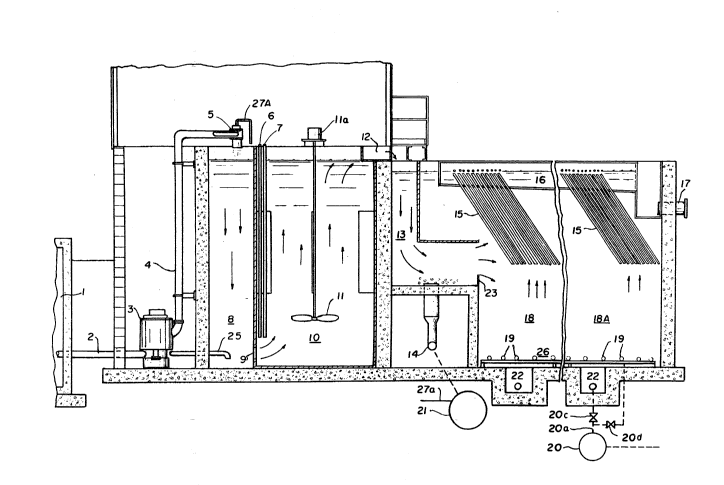Une partie des informations de ce site Web a été fournie par des sources externes. Le gouvernement du Canada n'assume aucune responsabilité concernant la précision, l'actualité ou la fiabilité des informations fournies par les sources externes. Les utilisateurs qui désirent employer cette information devraient consulter directement la source des informations. Le contenu fourni par les sources externes n'est pas assujetti aux exigences sur les langues officielles, la protection des renseignements personnels et l'accessibilité.
L'apparition de différences dans le texte et l'image des Revendications et de l'Abrégé dépend du moment auquel le document est publié. Les textes des Revendications et de l'Abrégé sont affichés :
| (12) Brevet: | (11) CA 1332006 |
|---|---|
| (21) Numéro de la demande: | 587726 |
| (54) Titre français: | SYSTEME DE TRAITEMENT DES DECHETS LIQUIDES |
| (54) Titre anglais: | LIQUID WASTE TREATMENT SYSTEM |
| Statut: | Réputé périmé |
| (52) Classification canadienne des brevets (CCB): |
|
|---|---|
| (51) Classification internationale des brevets (CIB): |
|
| (72) Inventeurs : |
|
| (73) Titulaires : |
|
| (71) Demandeurs : | |
| (74) Agent: | FETHERSTONHAUGH & CO. |
| (74) Co-agent: | |
| (45) Délivré: | 1994-09-13 |
| (22) Date de dépôt: | 1989-01-09 |
| Licence disponible: | S.O. |
| (25) Langue des documents déposés: | Anglais |
| Traité de coopération en matière de brevets (PCT): | Non |
|---|
| (30) Données de priorité de la demande: | S.O. |
|---|
ABSTRACT OF THE DISCLOSURE
A method of treating and progressively densifying liquid waste.
It comprises thoroughly mixing and aerating by a continuous mixer and/or
aerating raw water and chemical treating materials, discharging the
resulting mixture downwardly into a reaction compartment, thence
drawing the resulting material upwardly by means of an impeller and
gravity flow, then allowing a portion of the resulting denser sludge
to descend downwardly by gravity into a floc tunnel, thence in a
horizontal portion, further densifying and separating takes place. The
remaining portion is directed horizontally against inclined, closely
spaced parallel plates to clear the resulting fines mixture. Thereafter,
there is still further densifying the sludge. By this method, a
very dense sludge is obtained in a relatively small space.
Note : Les revendications sont présentées dans la langue officielle dans laquelle elles ont été soumises.
Note : Les descriptions sont présentées dans la langue officielle dans laquelle elles ont été soumises.

Pour une meilleure compréhension de l'état de la demande ou brevet qui figure sur cette page, la rubrique Mise en garde , et les descriptions de Brevet , États administratifs , Taxes périodiques et Historique des paiements devraient être consultées.
| Titre | Date |
|---|---|
| Date de délivrance prévu | 1994-09-13 |
| (22) Dépôt | 1989-01-09 |
| (45) Délivré | 1994-09-13 |
| Réputé périmé | 2003-09-15 |
Il n'y a pas d'historique d'abandonnement
| Type de taxes | Anniversaire | Échéance | Montant payé | Date payée |
|---|---|---|---|---|
| Le dépôt d'une demande de brevet | 0,00 $ | 1989-01-09 | ||
| Enregistrement de documents | 0,00 $ | 1989-03-20 | ||
| Enregistrement de documents | 0,00 $ | 1991-05-07 | ||
| Enregistrement de documents | 0,00 $ | 1994-07-15 | ||
| Taxe de maintien en état - brevet - ancienne loi | 2 | 1996-09-13 | 50,00 $ | 1996-06-06 |
| Taxe de maintien en état - brevet - ancienne loi | 3 | 1997-09-15 | 100,00 $ | 1997-07-10 |
| Taxe de maintien en état - brevet - ancienne loi | 4 | 1998-09-14 | 100,00 $ | 1998-09-14 |
| Taxe de maintien en état - brevet - ancienne loi | 5 | 1999-09-13 | 150,00 $ | 1999-09-09 |
| Taxe de maintien en état - brevet - ancienne loi | 6 | 2000-09-13 | 150,00 $ | 2000-08-22 |
| Taxe de maintien en état - brevet - ancienne loi | 7 | 2001-09-13 | 150,00 $ | 2001-09-12 |
Les titulaires actuels et antérieures au dossier sont affichés en ordre alphabétique.
| Titulaires actuels au dossier |
|---|
| HAZLETON ENVIRONMENTAL PRODUCTS INC. |
| W. & P. INVESTMENTS, INC. |
| Titulaires antérieures au dossier |
|---|
| DECKER, CLIFFORD J. |
| GALGON, RANDY A. |
| HAZLETON ENVIRONMENTAL PRODUCTS INC. |
| WERNER, ROY H. |